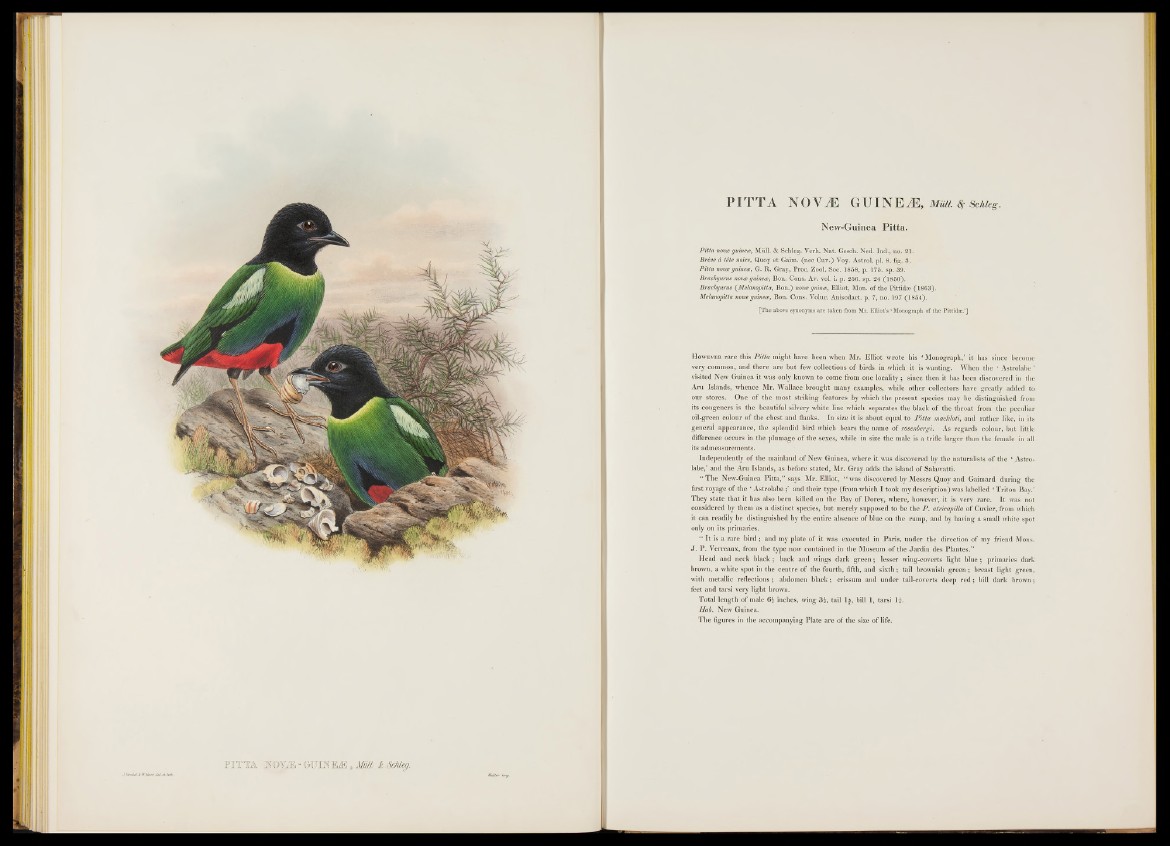
I
I
ITTA. ÏTOYâï ■ GUIHEÆ, M ill Jo Schleq.
PITTA NOYÆ GUINEÆ, müu. 8ç Sçhieg.
New-Guinea Pitta.
Pitta nova guinea, Miill. & Schleg. Verh. Nat. Gesch. Ned. Ind., no. 21.
Brève à tête noire, Quoy et Gaim. (nee Cuv.) Yoy. Astrol. pi. 8. fig. 3.
Pitta nova guinea, G. R. Gray, Proc. Zool. Soc. 1858, p. 175. sp. 39.
Brachyurus nova guinea, Bon. Cons. Ay. vol. i. p . 256. sp. 24 (1 8 5 0 ).
Brachyurus (Melanopitta, Bon.) nova guina, Elliot, Mon. of the Pittidee (1863).
Melanopitta nova guinea, Bon. Cons. Voluc. Anisodact. p. 7, no. 197 (1854).
[The above synonyms are taken from Mr. Elliot’s - Monograph of the Pittidæ.’]
H owever rare this Pitta might have been when Mr. Elliot wrote his ‘ M onograph,' it has since become
very common, and there are but few collections o f birds in which it is wanting. When the ‘ Astrolabe ’
visited New Guinea it was only known to come from one locality ; since then it has been discovered in the
Aru Islands, whence Mr. Wallace brought many examples, while other collectors have greatly added to
our stores. One o f the most striking features by which the present species may be distinguished from
its congeners is the beautiful silvery white line which separates the black o f the throat from the peculiar
oil-green colour o f the chest and flanks. In size it is about equal to Pitta mackloti, and rather like, in its
general appearance, the splendid bird which bears the name of rosenbergi. As regards colour, but little
difference occurs in the plumage o f the sexes, while in size the male is a trifle larger than the fern ale in all
its admeasurements.
Independently o f the mainland o f New Guinea, where it was discovered by the naturalists o f the ‘ Astrolabe,’
and the Aru Islands, as before stated, Mr. Gray adds the island o f Salawatti.
“ T he New-Guinea Pitta,” says Mr. Elliot, “ was discovered by Messrs Quoy and Gaimard during the
first voyage of the ‘ A strolabe;’ and their type (from which I took my description) was labelled ‘ T riton Bay.’
They state th at it has also been killed on the Bay o f Dorey, where, however, it is very rare. I t was not
considered by them as a distinct species, but merely supposed to be the P. atricapilla of Cuvier, from which
it can readily be distinguished by the entire absence o f blue on the rump, and by having a small white spot
only on its primaries.
“ I t is a rare bird ; and my plate o f it was executed in Paris, under the direction o f my friend Mons.
J . P. Verreaux, from the type now contained in the Museum o f the Jard in des Plantes.”
Head and neck b lack ; back and wings dark g r e e n ; lesser wing-coverts light b lu e ; primaries dark
brown, a white spot in the centre of the fourth, fifth, and s ix th ; tail brownish green ; breast light green,
with metallic reflections; abdomen b lack ; crissum and under tail-coverts deep r e d ; bill dark brown;
feet and tarsi very light brown.
Total length o f male 6£ inches, wing 3£, tail 1$, bill 1, tarsi If.
Hab. New Guinea.
The figures in the accompanying Plate are of the size o f life.